1998 GMC SIERRA tire type
[x] Cancel search: tire typePage 201 of 452
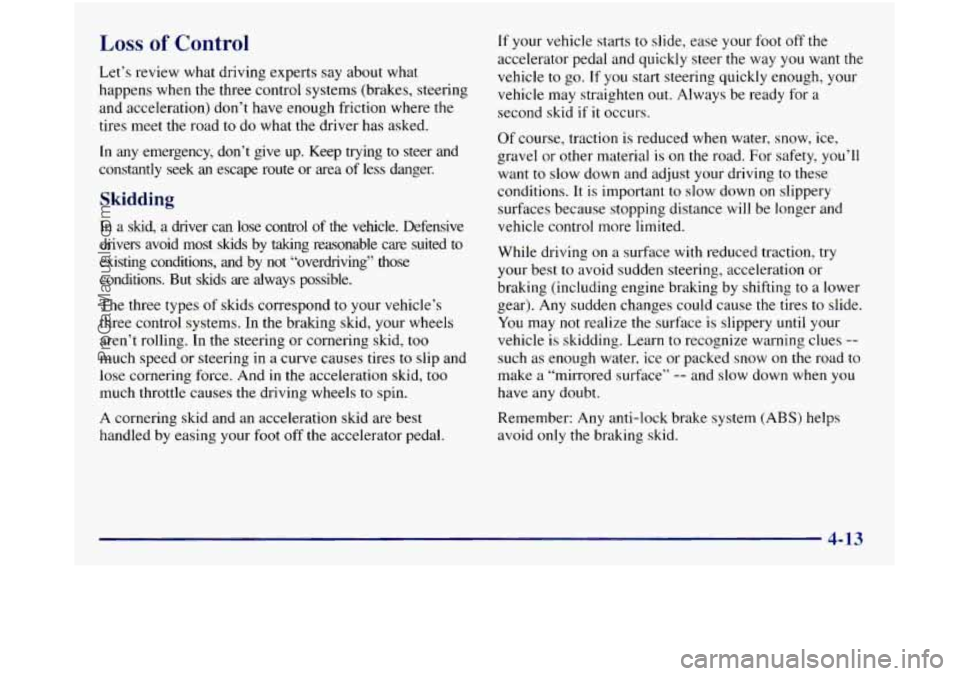
Loss of Control
Let’s review what driving experts say about what
happens when the three control systems (brakes, steering
and acceleration) don’t have enough friction where
the
tires meet the road to do what the driver has asked.
In any emergency, don’t give up. Keep trying to steer and
constantly seek an escape route or area of less danger.
Skidding
In a skid, a driver can lose control of the vehicle. Defensive
drivers avoid most skids by taking reasonable care suited
to
existing conditions, and by not “overdriving” those
conditions. But skids are always possible.
The three types of skids correspond
to your vehicle’s
three control systems. In the braking skid, your wheels
aren’t rolling. In the steering or cornering skid,
too
much speed or steering in a curve causes tires to slip and
lose cornering force. And
in the acceleration skid, too
much throttle causes the driving wheels to spin.
A cornering skid and an acceleration skid are best
handled by easing your foot off the accelerator pedal. If
your vehicle starts
to slide, ease your foot off the
accelerator pedal and quickly steer the way you want the
vehicle
to go. If you start steering quickly enough, your
vehicle may straighten out. Always be ready for
a
second skid if it occurs.
Of course, traction
is reduced when water, snow, ice.
gravel or other material
is on the road. For safety, you’ll
want to slow down and adjust your driving to these
conditions.
It is important to slow down on slippery
surfaces because stopping distance will be longer and
vehicle control more limited.
While driving on a surface
with reduced traction, try
your best to avoid sudden steering, acceleration or
braking (including engine braking
by shifting to a lower
gear). Any sudden changes could cause the tires
to slide.
You may not realize the surface is slippery until your
vehicle is skidding. Learn to recognize warning clues
--
such as enough water, ice or packed snow on the road to
make
a “mirrored surface” -- and slow down when you
have any doubt.
Remember:
Any anti-lock brake system (ABS) helps
avoid only the braking skid.
4-13
ProCarManuals.com
Page 343 of 452

When to Check
Check your tires once a month or more. Also, check the
tire pressure of the spare tire.
How to Check
Use a good quality pocket-type gage to check tire
pressure. You can’t tell if your tires are properly inflated
simply by looking at them. Radial tires may
look
properly inflated even when they’re underinflated.
Be sure
to put the valve caps back on the valve stems.
They help prevent leaks by keeping out dirt and moisture.
Tire Inspection and Rotation
Tires should be rotated every 6,000 to 8,000 miles
(10 000 to 13 000 km). Any time you notice unusual
wear, rotate your tires as soon as possible and check
wheel alignment.
Also check for damaged tires or
wheels.
See “When It‘s Time for New Tires” and
“Wheel Replacement” later in this section for more
information. If your vehicle has dual rear wheels, also
see “Dual Tire Operation” later
in this section. The purpose
of regular rotation
is to achieve more
uniform wear
for all tires on the vehicle. The first
rotation is the most important. See “Scheduled
Maintenance Services”
in the Index for scheduled
rotation intervals.
1
FRT FRT
[x[
If your vehicle has single rear wheels, always use one of
the correct rotation patterns shown here when rotating
your tires.
If your vehicle has front tires with different load ranges
or tread designs (such as all season vs. on/off road) than
the rear tires, don’t rotate your tires front
to rear.
6-53
ProCarManuals.com
Page 347 of 452
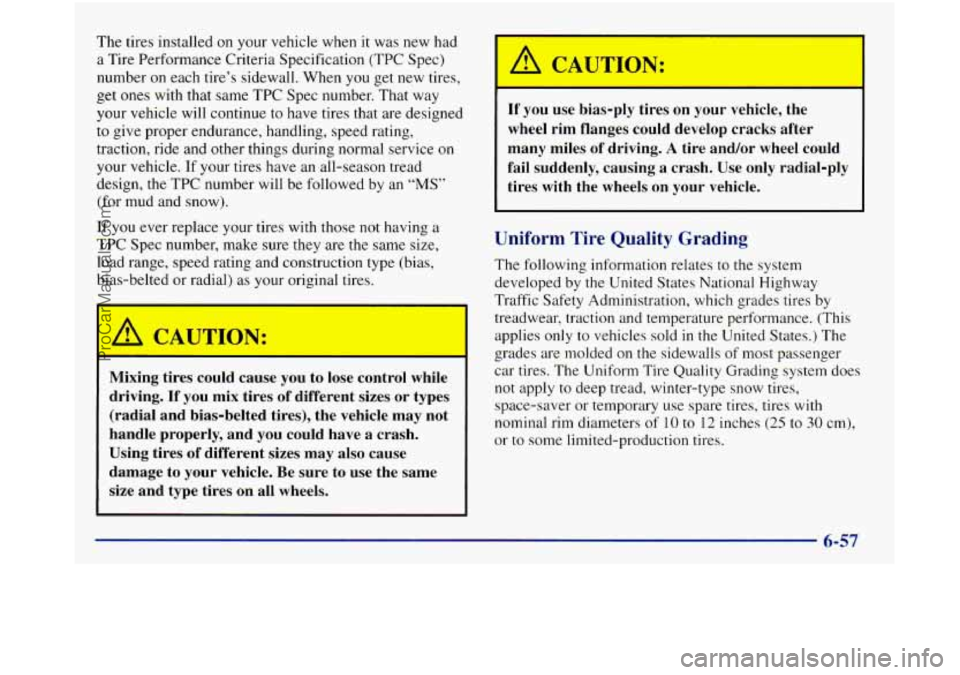
The tires installed on your vehicle when it was new had
a Tire Performance Criteria Specification (TPC Spec)
number on each tire’s sidewall. When
you get new tires,
get ones with that same TPC Spec number. That way
your vehicle will continue to have tires that are designed
to give proper endurance, handling, speed rating,
traction, ride and other things during normal service
on
your vehicle. If your tires have an all-season tread
design, the
TPC number will be followed by an “MS”
(for mud and snow).
If you ever replace your tires with those not having a
TPC Spec number, make sure they are the same size,
load range, speed rating and construction type (bias,
bias-belted or radial) as your original tires.
Mixing tires could cause you to lose control while
driving.
If you mix tires of different sizes or types
(radial and bias-belted tires), the vehicle may not
handle properly, and you could have a crash.
Using tires of different sizes may also cause
damage to your vehicle. Be sure to use the same
size and type tires on all wheels.
I A CAUTION:
If you use biasuply tires on your vehicle, the
wheel rim flanges could develop cracks after
many miles of driving.
A tire and/or wheel could
fail suddenly, causing a crash. Use only radial-ply
tires with the wheels on your vehicle.
Uniform Tire Quality Grading
The following information relates to the system
developed by the United States National Highway
Traffic Safety Administration, which grades tires by
I treadwear, traction and temperature performance. (This
applies only to vehicles sold
in the United States.) The
grades are molded on the sidewalls of most passenger
car tires. The Uniform Tire Quality Grading system does
not apply to deep tread, winter-type snow tires,
space-saver or temporary use spare tires, tires
with
nominal rim diameters of 10 to I2 inches (25 to 30 cm),
or to some limited-production tires.
6-57
ProCarManuals.com
Page 350 of 452
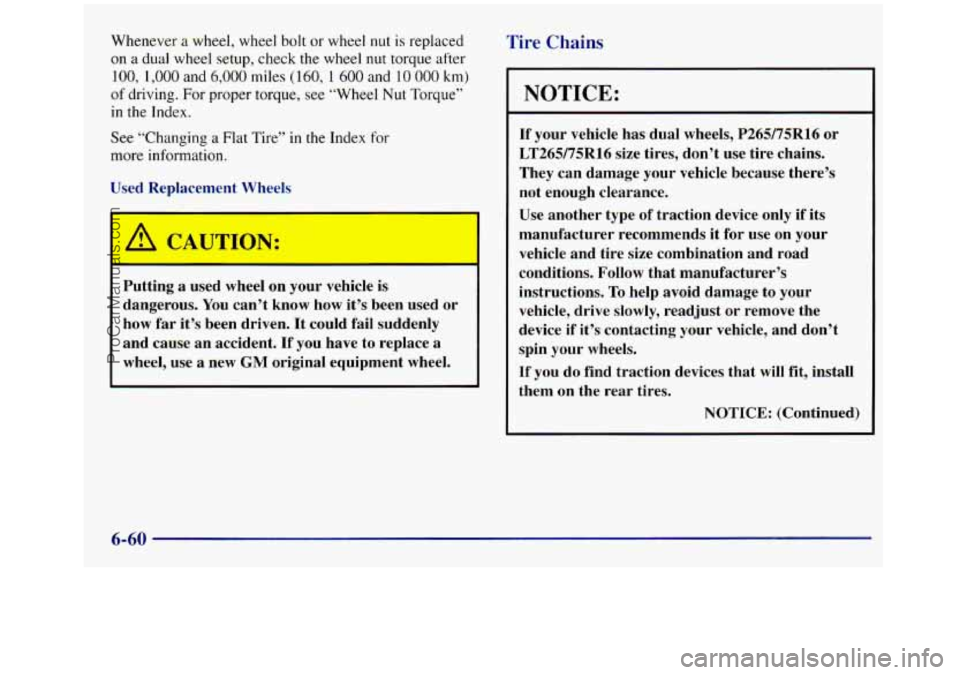
Whenever a wheel, wheel bolt or wheel nut is replaced
on
a dual wheel setup, check the wheel nut torque after
100, 1,000 and 6,000 miles ( 160, 1 600 and 10 000 km)
of driving. For proper torque, see “Wheel Nut Torque’’
in the Index.
See “Changing
a Flat Tire” in the Index for
more information.
Used Replacement Wheels
/!1 CAUTION:
Putting a used wheel on your vehicle is
dangerous.
You can’t know how it’s been used or
how
far it’s been driven. It could fail suddenly
and cause an accident. If
you have to replace a
wheel, use a new GM original equipment wheel.
Tire Chains
NOTICE:
If your vehicle has dual wheels, P265/75R16 or
LT265/75R16 size tires, don’t use tire chains.
They can damage your vehicle because there’s
not enough clearance.
Use another type of traction device only
if its
manufacturer recommends it for
use on your
vehicle and tire size combination and road
conditions.
Follow that manufacturer’s
instructions. To help avoid damage to your
vehicle, drive slowly, readjust or remove the
device
if it’s contacting your vehicle, and don’t
spin your wheels.
If you do find traction devices that will fit, install
them on the rear tires.
NOTICE: (Continued)
6-60
ProCarManuals.com
Page 359 of 452

Appearance Care Materials Chart
PART NUMBER SIZE DESCRIPTION USAGE
994954 23 in. x 25 in. Polishing Cloth - Wax Treated
Exterior polishing cloth
1050172 16
oz. (0.473 L) Tar and Road Oil Remover Removes tar, road oil and asphalt
1050173 16
oz. (0.473 L) Chrome Cleaner and Polish Use on chrome, stainless steel, nickel, copper and brass
1050 174 16
oz. (0.473 L) White Sidewall Tire Cleaner Removes soil and black marks from whitewalls
1050214 32
oz. (0.946 L) Vinyl Cleaner Cleans vinyl tops, upholstery and convertible tops
1050427 23
oz. (0.680 L) Glass Cleaner Removes dirt, grime,
smoke and fingerprints
1052870
16 oz. (0.473 L) Wash Wax Concenmace Cleans and lightly waxes ~.
1052918”” 8 oz. (0.237 L) Armor All Protectant Protects
leather, wood, acrylics, Plexiglas TM , plastic,
rubber and vinyl
1052925
[ 16 oz. (0.473 L) I Multi-Purpose Interior Cleans carpets, seats, interior trim, door panels
I Cleaner and floor mats I I
1052929 I 16 oz. (0.473 L) I Wheel Cleaner I Spray on and rinse with water
1052930
8 oz. (0.237 L) Capture Dry Spot Remover
Attracts, absorbs and removes soils
12345002
16 oz. (0.473 L) Armor All” Cleaner Cleans
and shines a variety of surface types
12345721 2.5
sq. ft. Synthetic Chamois
Shines vehicle without scratching
12345725 12
oz. (0.354 L) Silicone Tire Shine Spray
on tire shine
12377964 16
oz. (0.473 L) Finish Enhancer Removes dust, fingerprints andsurface contaminants
12377966 16
oz. (0.473 L) Cleaner Wax Removes light scratches and oxidation and protects fish
12377984
I 16 oz. (0.473 L) I Surface Cleaner I Removes contaminants, blemishes and swirl marks
See your General Motors Parts Department for these products.
** Not recommended for use on instrument panel vinyl.
See “Fluids and Lubricants’’ in the Index.
6-69
ProCarManuals.com
Page 367 of 452
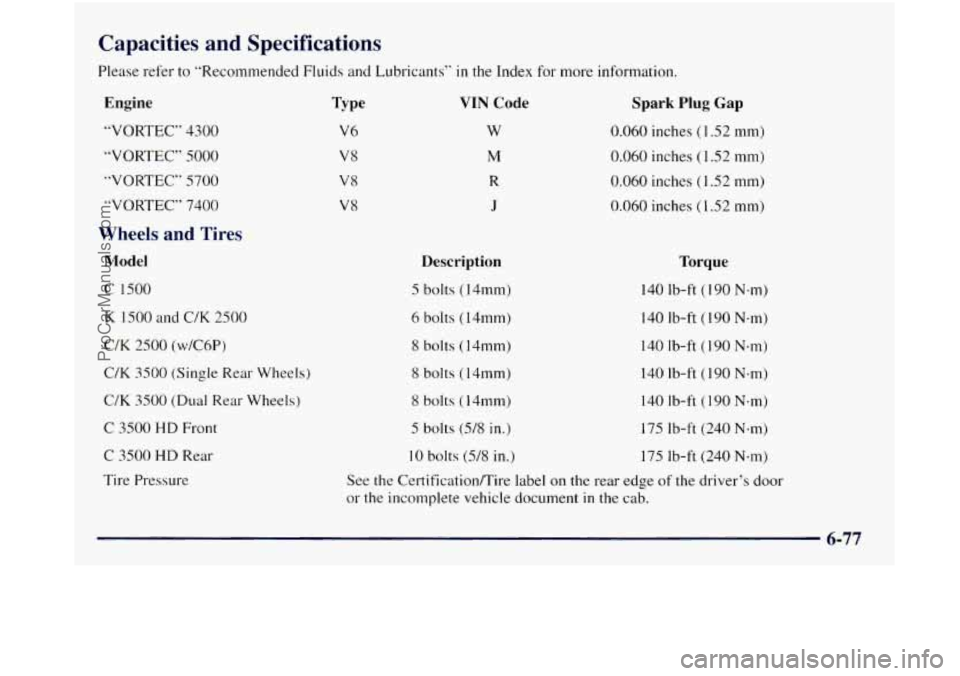
Capacities and Specifications
Please refer to ”Recommended Fluids and Lubricants” in the Index for more information.
Engine
“VORTEC” 4300
“VORTEC” 5000
”VORTEC“ 5700
“VORTEC“ 7400
Wheels and Tires
Model
C 1500
K 1500 and C/K 2500
C/K 2500 (w/C6P)
C/K
3500 (Single Rear Wheels)
C/K 3500 (Dual Rear Wheels)
C 3500 HD Front
C 3500 HD Rear
Tire Pressure
Type
V6
V8
V8
V8
VIN Code
w
M
R
J
Spark Plug Gap
0.060 inches ( 1.52 mm)
0.060 inches
(I .52 mm)
0.060 inches (1.52 mm)
0.060 inches (1 32 mm)
Description Torque
5 bolts (14mm) 140 lb-ft ( 190 Nem)
6 bolts
(14mm) 140 Ib-ft (190 N-m)
8 bolts (14mm) 140 lb-ft ( 190 N-m)
8 bolts
(14mm) 140 lb-ft ( 190 N-m)
8 bolts
(14mm) 140 lb-ft (190 Nsm)
5 bolts (5/8 in.) 175 Ib-ft (240 N-m)
10 bolts (5/8 in.)
175 lb-ft (240 Nem)
See the Certificationflire label on the rear edge of the driver’s door
or the incomplete vehicle document
in the cab.
6-77
ProCarManuals.com
Page 445 of 452
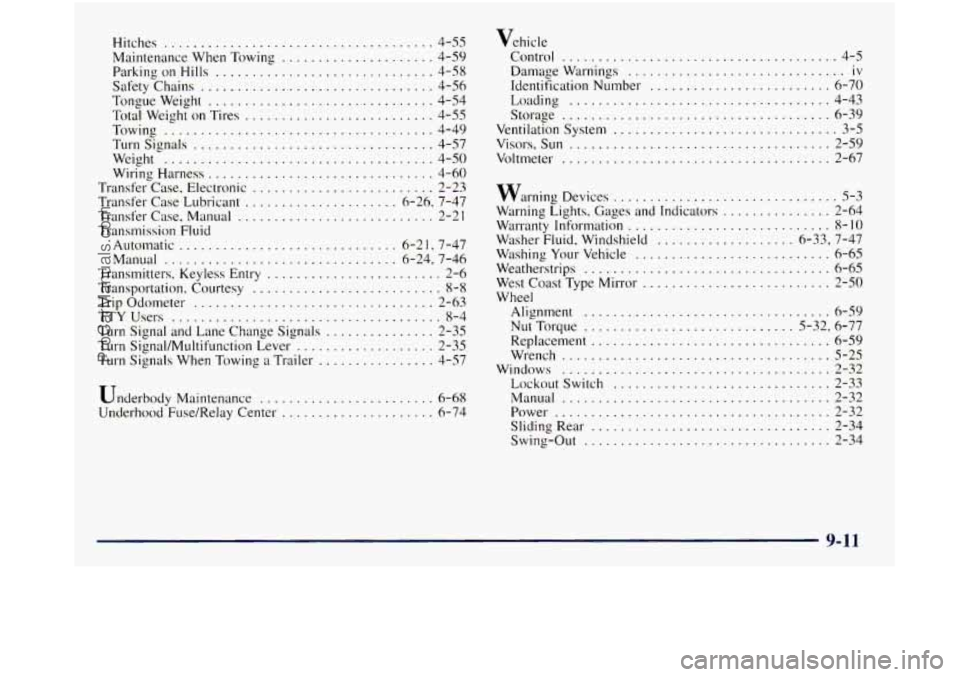
Hitches ..................................... 4-55
Maintenance When Towing
..................... 4-59
Parking on Hills
.............................. 4-58
Safety Chains
................................ 4-56
Tongueweight
............................... 4-54
Total Weight on Tires
.......................... 4-55
Towing
..................................... 4-49
Turn Signals ................................. 4-57
Weight
..................................... 4-50
Wiring Harness
............................... 4-60
Transfer Case. Electronic
......................... 2-23
Transfer Case Lubricant ..................... 6-26 . 7-47
Transfer Case. Manual
........................... 2-2 1
Transmission Fluid
Automatic
.............................. 6-2 1.7-47
Manual
................................ 6-24. 7-46
Transmitters. Keyless Entry
........................ 2-6
Transportation
. Courtesy .......................... 8-8
Trip Odometer ................................. 2-63
TTYUsers
..................................... 8-4
Turn Signal and Lane Change Signals
............... 2-35
Turn SignaVMultifunction Lever
................... 2-35
Turn Signals When Towing a Trailer
................ 4-57
Underbody Maintenance
........................ 6-68
Underllood-Fuse/Relay Center
..................... 6-74 Vehicle
Control
...................................... 4-5
Damage Warnings
.............................. iv
Identification Number ......................... 6-70
Loading
.................................... 4-43
Storage
..................................... 6-39
Ventilation System
............................... 3-5
Visors. Sun .................................... 2-59
Voltmeter
..................................... 2-67
warning Devices
............................... 5-3
Wxranty Information
............................ 8- IO
Washer Fluid. Windshield ................... 6.33. 7-47
Washing
Your Vehicle ........................... 6-65
Weatherstrips
.................................. 6-65
West Coast Type Mirror
.......................... 2-50
Wheel Warning
Lights
. Gages and Indicators ............... 2-64
Alignment
.................................. 6-59
Nut Torque ............................. 5-32. 6-77
Replacement
................................. 6-59
Wrench
..................................... 5-25
Windows
..................................... 2-32
Lockout Switch
.............................. 2-33
Manual
..................................... 2-32
Power
...................................... 2-32
Sliding Rear
................................. 2-34
Swing-Out
.................................. 2-34
9-11
ProCarManuals.com